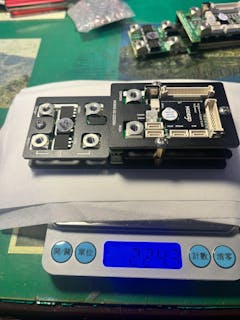Product Description--
Parameters:
Quantity of series connection: 4S (Can drop series usage, downward compatible)
Applicable battery: 3.2V/3.65V; 3.7V/4.2V lithium battery or lithium iron phosphate
Not applicable to: Farad capacitors, lithium titanate batteries
Balance method: active energy transfer
Balanced efficiency: 92%
Working temperature: about 30-65℃
Balance logic: Take two adjacent cells as the unit, and multi-column synchronization is carried out
Start condition: Adjacent voltage difference>0.1V
Balance current: 800MA
Balance stop: adjacent voltage difference <0.03V
Equalization period: full voltage section (including charging, discharging, idle)
Low voltage protection: battery voltage is lower than 2.5V
Sleep power consumption: 2uA low power consumption, the battery can be idle for a long time
Balance indicator: light on means balance is in progress, light off means balance is complete, flashing means battery internal resistance is large or the string is dropped or drop series in the air
Built-in installation: suitable for long-term use of battery internal installation
Other instructions: with the protection plate or use the protection board with passive balance at the same time, without affecting each other
Wiring logic: take GND as the total negative pole to connect in the forward direction, can not be wrong or reversed
Working Principle:
The balance circuit is used to balance the voltage difference and capacity difference between the batteries, and is used with the original protection board (or the protection board with passive balance) to give better performance of the battery pack.
This product is an active balancing circuit. The voltages of two adjacent batteries are compared with each other, and they work in the way of energy transfer. Each group is independently synchronized and balanced and compared with each other. It is not simply understood as gradual transfer.
Compared with traditional passive equalization, this product has high efficiency and lower heat generation, and can be equalized regardless of whether the battery is idle, charged or discharged.

Take the 6S battery pack as an example in the figure above. As long as the adjacent voltage difference is above 0.1V, the 2nd battery will charge the 1st and 3rd batteries at the same time. At this moment, the 5th battery is also simultaneously charged for the 4th battery. When their voltage difference reaches 0.03V, they stop charging and enter a dormant state. During the balancing process, the maximum balancing current can reach 1.2A, and the smaller the voltage difference, the smaller the balancing current. The voltage difference between the batteries changes dynamically with the effect of charge and discharge and balance, so there will be no accumulation of the voltage difference.
Cascading or drop series
Cascading expansion or drop series, as shown in the figure below, the cascade between the two boards needs to be connected with 2 wires in parallel. Therefore, after the actual cascade of 4S+4S is 4+3=7S, if it is 4S+4S+4S after the actual cascade, it is 4+3+3=10S.
The drop series is relatively easy to use, (the battery position of the drop series can be left in the air. For example, if the 4S board is connected to the 3S battery, just leave the last wire in the air and not connect it)




Dimensions: 53*18*6.7mm
Net weight: 7.3g
Weight with package: 20g
Shipping packaging:
1* PCBA active equalizer board
1* HY2.0 single head 5P line
























